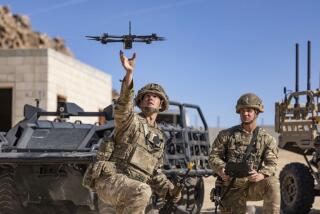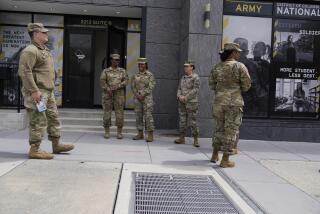China’s Vast Military Cuts Fat, Adds Muscle
- Share via
BEIJING — China, which has the largest military force in the world, is making important strides toward developing a lean, high-tech fighting machine, the People’s Liberation Army said Monday.
A two-year slim-down program has eliminated more than 200,000 jobs, or about 9% of the service, according to the PLA’s official newspaper. By year end, that left a total of about 2.3 million members, a 45% reduction since 1987.
“Our military is marching towards the goal of an appropriately sized, structurally balanced, lean, command-responsive fighting force,” the official Liberation Army Daily said.
The PLA has made no secret of its effort to craft a slimmer, more mobile force versed in the use of advanced weaponry as a source of national pride and a deterrent to Taiwanese independence. In an environment in which too many officers and poorly educated soldiers undercut efficiency, these staffing reductions are in line with analysts’ expectations. But the downsizing has engendered less obvious social changes, the analysts say.
In recent months, China has seen more protests by uniformed and retired military personnel over pay and pensions as the institution’s ambitions outpace its resources. It has also faced grumbling from those who have been laid off. Many are less educated and feel let down by an organization that Mao Tse-tung once heralded as virtually indistinguishable from the Chinese people, as “integral to the society around it as fish to water.”
“This reaction is natural and normal,” said Liu Yongsheng, analyst with the Beijing-based China Arms Control and Disarmament Assn., a government-linked think tank. “Certainly many are not happy with the layoffs. But it’s necessary, and the government has considered all this. In Chinese, we say it’s better to suffer short-term pain than long-term pain.”
At a time when Beijing is grappling with unrest around the nation, the specter of public protests by men and women in uniform has been particularly unsettling. In April, about 2,000 retired troops from around China staged a three-day sit-in in the capital demanding higher pensions, reportedly the most extensive protest by veterans since 1949.
In August, China’s Central Military Commission warned PLA members never to take part in street protests or put the interests of the army above those of the Communist Party. Any activities that challenged single-party rule would be severely punished, it added.
“It’s a bad sign any time the military protests,” said Wendell Minnick, a Taiwan correspondent with Jane’s Defense Weekly, a publication that researches military issues. “They really depend on these guys to put down other protests. You can’t have these guys running around protesting with guns.”
Generals also have more subtle headaches. As they hire better-educated people to fill the ranks, a generation brought up in shopping malls and karaoke halls and used to having much more personal choice than their parents inevitably exerts more pressure for change.
“This is challenging China’s highly centralized military system,” said Andrew Yang, secretary-general of the Chinese Council of Advanced Policy Studies in Taiwan. “The bottom-up pressure is rampant.”
China is also working overtime to lighten many of the army’s ancillary responsibilities, including planting crops, teaching school and running shops. These activities grew out of a tradition dating back to the conflicts with the Japanese and the Nationalists, when fighters were supposed to be self-sufficient.
Given today’s emphasis on technology, professionalism, mobility and rapid response, analysts say these duties are not only distracting but demeaning for soldiers.
“That’s the old system; it doesn’t work anymore,” Minnick said. “Now you want to hire [civilians] to plant crops.”
China’s official military budget in 2005 was about $30 billion, a 12.6% increase from the prior year. The U.S., in comparison, earmarked $420.7 billion for defense in the 2005 fiscal year. Some analysts, though, believe Beijing’s actual budget is larger than reported. The U.S. has far fewer military personnel than China: about 1.39 million on active duty worldwide in September, according to the Pentagon.
As part of its restructuring program, the Chinese army has sought to acquire more high-tech equipment and tried to strengthen the effectiveness of how decisions are made and carried out, known in military parlance as command and control.
The infantry now makes up an all-time low proportion of the force, the army newspaper said, whereas the shares of the navy, air force and Second Artillery Corps, which oversees China’s nuclear missiles, are rising.
The government has been lobbying the European Union to end its ban on weapon sales, so far without success. Washington has urged the EU not to lift the ban. This has left Russia as Beijing’s primary supplier of military hardware.
In August, China and Russia cooperated in the largest joint military exercise in decades, descending on China’s Shandong peninsula with 10,000 troops and a range of sophisticated weapons. Russia is expected to hold a similar exercise on its territory this year. Analysts believe the exercises are partly meant to showcase Russian technology for Chinese buyers.
A longer-range objective for China, analysts say, is to build a home-grown arms manufacturing capability. Although Moscow is eager to earn more hard currency from its aging militaryindustrial complex, analysts say it is wary of selling its best technology to a potential rival.
*
(BEGIN TEXT OF INFOBOX)
Armed might around the globe
Active-duty personnel
*--* 1. China 2,250,000 2. U.S.* 1,625,852 3. India 1,325,000 4. N. Korea 1,075,000 5. Russia 960,000 6. S. Korea 685,000 7. Pakistan 620,000 8. Iran 540,000 9. Britain 515,000 10. Turkey 515,000 11. Myanmar 490,000 12. Vietnam 485,000 13. Egypt 450,000 14. Syria 320,000 15. Thailand 315,000 16. Ukraine 295,000 17. Taiwan 290,000 18. Brazil 285,000 19. Germany 284,000 20. France 259,000
*--*
* Includes mobilized National Guard and Reserve
Source: GlobalSecurity.org
More to Read
Sign up for Essential California
The most important California stories and recommendations in your inbox every morning.
You may occasionally receive promotional content from the Los Angeles Times.










